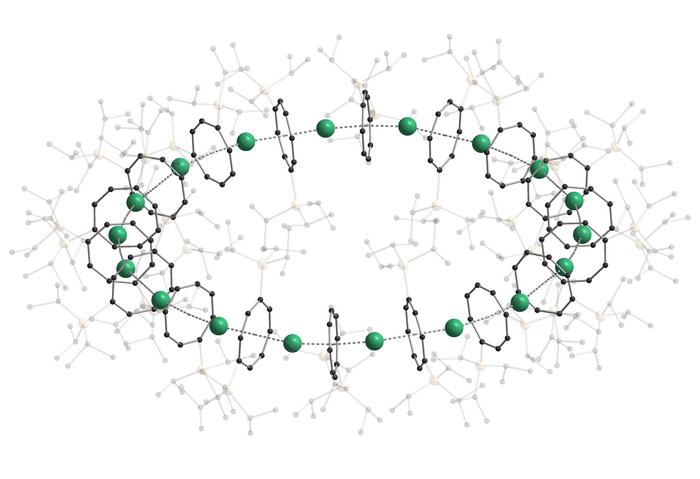Sandwich complexes were developed about 70 years ago and have a sandwich-like structure. Two flat aromatic organic rings (the “slices of bread”) are filled with a single, central metal atom in between. Like the slices of bread, both rings are arranged in parallel. Adding further layers of ‘bread’ and ‘filling’ produces triple or multiple sandwiches. “These compounds are among the most important complexes used in modern organometallic chemistry,” says Professor Peter Roesky from KIT’s Institute for Inorganic Chemistry. One of them is the highly stable ferrocene, for which its “fathers” Ernst Otto Fischer and Geoffrey Wilkinson were awarded the Nobel Prize in Chemistry in 1973. Ferrocene consists of an iron ion and two five-membered aromatic organic rings. It is used in synthesis, catalysis, electrochemistry, and polymer chemistry.

Credit: Photo: Nature / AOC, KIT
Sandwich complexes were developed about 70 years ago and have a sandwich-like structure. Two flat aromatic organic rings (the “slices of bread”) are filled with a single, central metal atom in between. Like the slices of bread, both rings are arranged in parallel. Adding further layers of ‘bread’ and ‘filling’ produces triple or multiple sandwiches. “These compounds are among the most important complexes used in modern organometallic chemistry,” says Professor Peter Roesky from KIT’s Institute for Inorganic Chemistry. One of them is the highly stable ferrocene, for which its “fathers” Ernst Otto Fischer and Geoffrey Wilkinson were awarded the Nobel Prize in Chemistry in 1973. Ferrocene consists of an iron ion and two five-membered aromatic organic rings. It is used in synthesis, catalysis, electrochemistry, and polymer chemistry.
First Nano-Sized Rings
For some time now, researchers of KIT and the University of Marburg have tried to arrange sandwich complexes in a ring. “We succeeded in producing chains, but no rings,” Roesky says, who coordinated the work of three teams at the two universities. “Thanks to the choice of the right ‘slice of bread’ or organic intermediate deck, we have now succeeded in forming nano-sized rings for the first time,” say Professor Manfred Kappes, who heads the Division of Physical Chemistry of Microscopic Systems at KIT, and Professor Florian Weigend, Head of the Applied Quantum Chemistry Unit of the University of Marburg. The new nanoring consists of 18 building blocks and has an outer diameter of 3.8 nanometers. Depending on the metal used as the ‘filling’ of the sandwich, an orange-colored photoluminescence results. The new chemical compound was called ‘cyclocene’ by the researchers.
The Nanoring Is Held Together by Itself
The three working groups carried out elaborate quantum chemical calculations to find out why the molecules could be arranged in a ring and no longer formed a chain of sandwich complexes. These calculations revealed that the driving force for the ring formation is the energy gained by the ring closure. “Our challenge initially was to form a ring. Can other ring sizes be produced? Does this nanostructure possess unusual physical properties? This will be subject of further research. But it is clear now that we have added a new building block to our toolbox of organometallic chemistry. And this is great,” Roesky says.
Original Publication
Luca Münzfeld, Sebastian Gillhuber, Adrian Hauser, Sergei Lebedkin, Pauline Hädinger, Nicolai D. Knöfel, Christina Zovko, Michael T. Gamer, Florian Weigend, Manfred M. Kappes, Peter W. Roesky, “Synthesis and properties of cyclic sandwich compounds.” Nature, 2023. DOI: 10.1038/s41586-023-06192-4
https://www.nature.com/articles/s41586-023-06192-4
More information on the Collaborative Research Center “4f for Future”
More about the KIT Materials Center
Being “The Research University in the Helmholtz Association”, KIT creates and imparts knowledge for the society and the environment. It is the objective to make significant contributions to the global challenges in the fields of energy, mobility, and information. For this, about 9,800 employees cooperate in a broad range of disciplines in natural sciences, engineering sciences, economics, and the humanities and social sciences. KIT prepares its 22,300 students for responsible tasks in society, industry, and science by offering research-based study programs. Innovation efforts at KIT build a bridge between important scientific findings and their application for the benefit of society, economic prosperity, and the preservation of our natural basis of life. KIT is one of the German universities of excellence.
Journal
Nature
DOI
10.1038/s41586-023-06192-4
Method of Research
Experimental study
Subject of Research
Not applicable
Article Title
Synthesis and properties of cyclic sandwich compounds
Article Publication Date
2-Aug-2023
COI Statement
The authors declare no competing interests.




